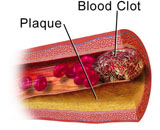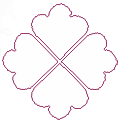Autologous Thrombus (AT)

A thrombus, colloquially called a blood clot, is the final product of the blood coagulation step in hemostasis. There are two components to a thrombus: aggregated platelets and red blood cells that form a plug, and a mesh of cross-linked fibrin protein. The substance making up a thrombus is sometimes called cruor. A thrombus is a healthy response to injury intended to prevent bleeding, but can be harmful in thrombosis, when clots obstruct blood flow through healthy blood vessels.
Mural thrombi are thrombi that adhere to the wall of a blood vessel. They occur in large vessels such as the heart and aorta, and can restrict blood flow but usually do not block it entirely.
Organism species: Mus musculus (Mouse)
- Disease model DSI679Mu01 Mouse Model for Autologous Thrombus (AT) In Stock
- Disease model DSI679Mu02 Mouse Model for Autologous Thrombus (AT) In Stock
- Disease model DSI679Mu03 Mouse Model for Autologous Thrombus (AT) In Stock
- Customized Service n/a Tissue of Autologous Thrombus (AT) (If Necessary) Tissue Customized Service Offer
- Customized Service n/a Serums of Autologous Thrombus (AT) (If Necessary) Serums Customized Service Offer
Organism species: Rattus norvegicus (Rat)
- Disease model DSI679Ra01 Rat Model for Autologous Thrombus (AT) In Stock
- Disease model DSI679Ra02 Rat Model for Autologous Thrombus (AT) In Stock
- Disease model DSI679Ra03 Rat Model for Autologous Thrombus (AT) In Stock
- Customized Service n/a Tissue of Autologous Thrombus (AT) (If Necessary) Tissue Customized Service Offer
- Customized Service n/a Serums of Autologous Thrombus (AT) (If Necessary) Serums Customized Service Offer
Organism species: Cavia (Guinea pig )
- Disease model DSI679Gu01 Cavia Model for Autologous Thrombus (AT) In Stock
- Disease model DSI679Gu02 Cavia Model for Autologous Thrombus (AT) In Stock
- Disease model DSI679Gu03 Cavia Model for Autologous Thrombus (AT) In Stock
- Customized Service n/a Tissue of Autologous Thrombus (AT) (If Necessary) Tissue Customized Service Offer
- Customized Service n/a Serums of Autologous Thrombus (AT) (If Necessary) Serums Customized Service Offer
Organism species: Oryctolagus cuniculus (Rabbit)
- Disease model DSI679Rb01 Rabbit Model for Autologous Thrombus (AT) In Stock
- Disease model DSI679Rb02 Rabbit Model for Autologous Thrombus (AT) In Stock
- Disease model DSI679Rb03 Rabbit Model for Autologous Thrombus (AT) In Stock
- Customized Service n/a Tissue of Autologous Thrombus (AT) (If Necessary) Tissue Customized Service Offer
- Customized Service n/a Serums of Autologous Thrombus (AT) (If Necessary) Serums Customized Service Offer
Organism species: Canis familiaris; Canine (Dog)
- Disease model DSI679Ca01 Canine Model for Autologous Thrombus (AT) In Stock
- Customized Service n/a Tissue of Autologous Thrombus (AT) (If Necessary) Tissue Customized Service Offer
- Customized Service n/a Serums of Autologous Thrombus (AT) (If Necessary) Serums Customized Service Offer


